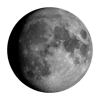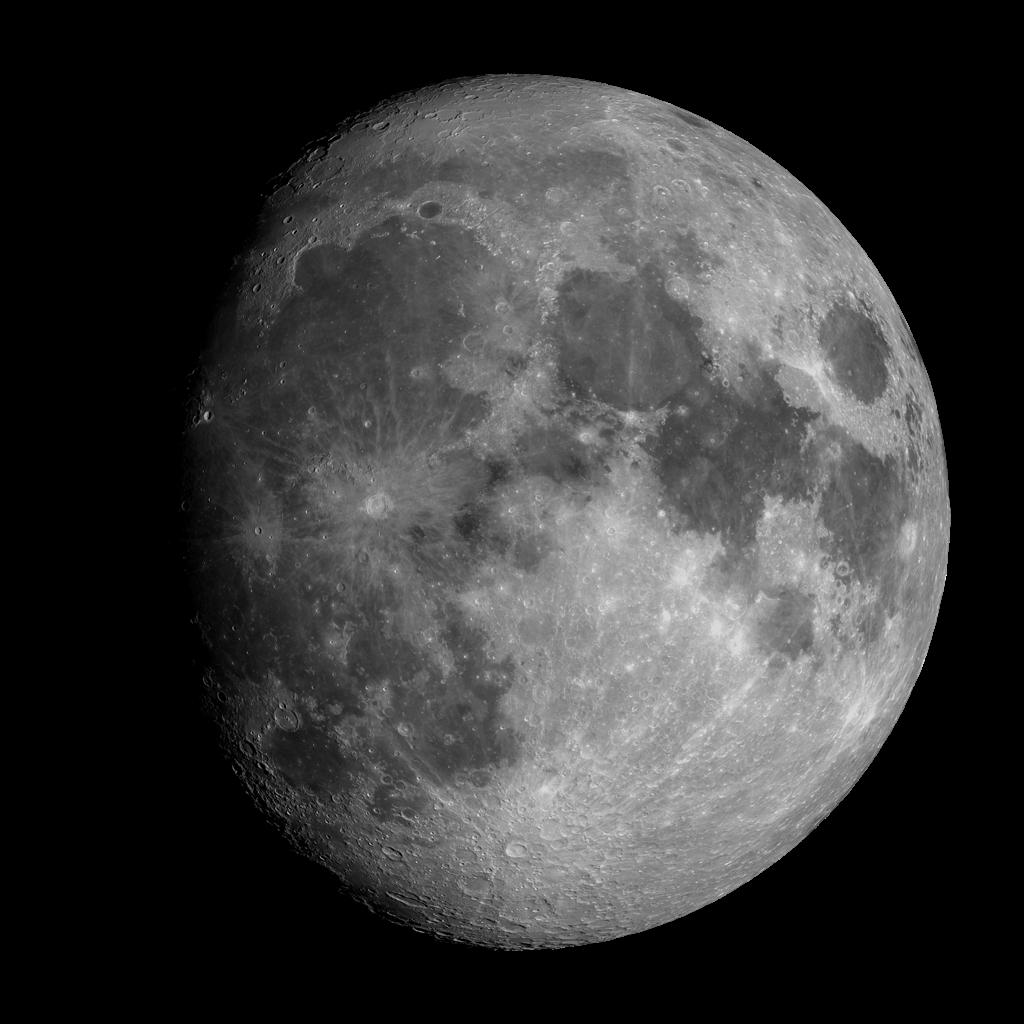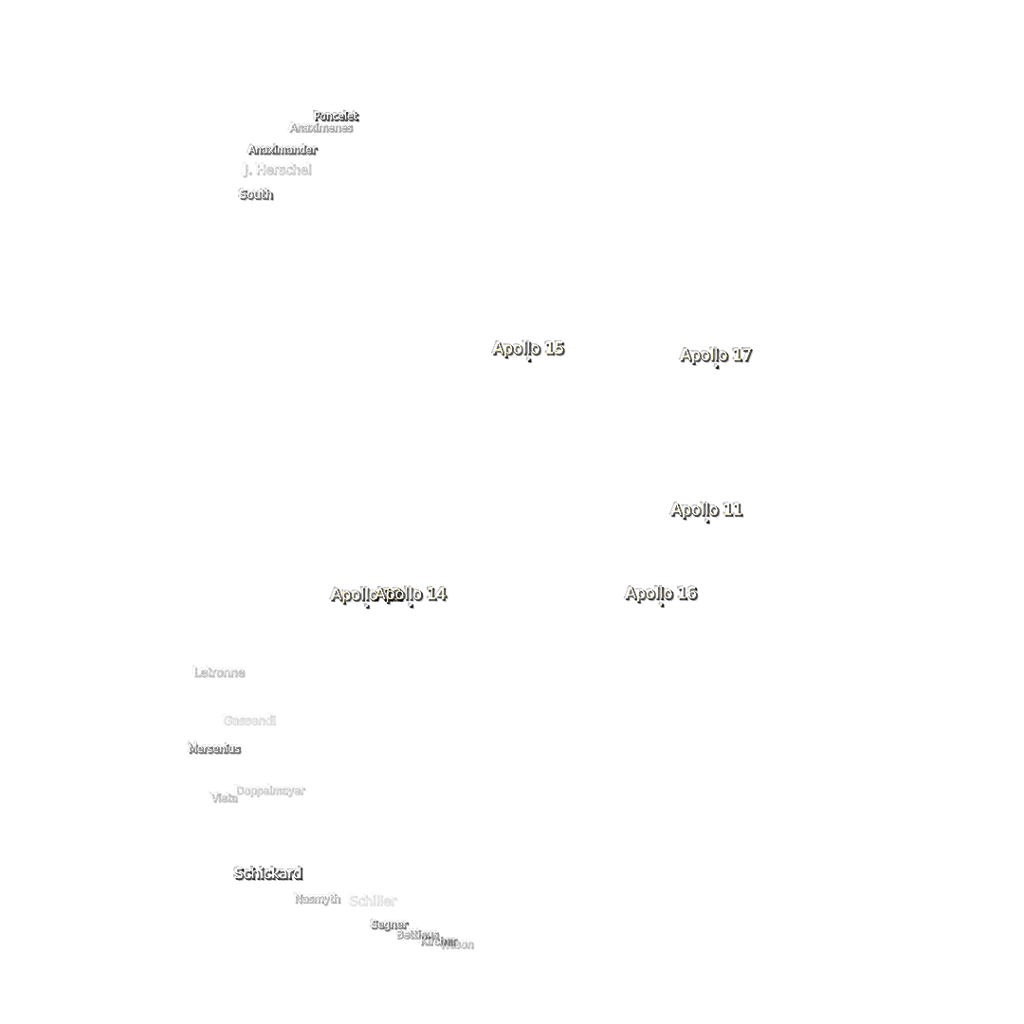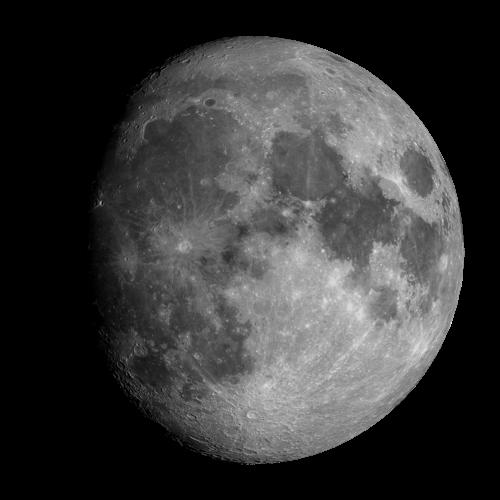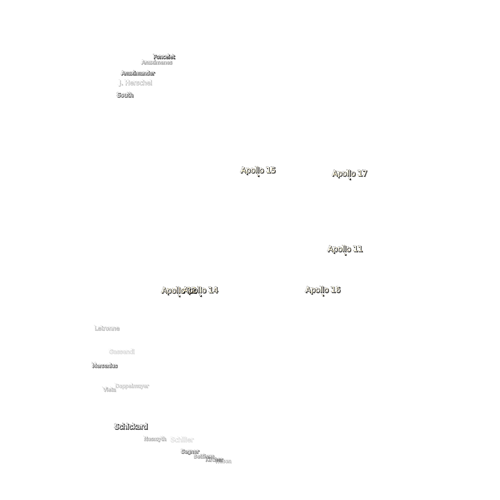The Moon
Today the Moon is the constellation of Libra, at a distance of
The image below shows the actual appearance of today's Moon phase. Check out the list of prominent lunar features suitable for observations today.
Credits: this image is derived from original work by NASA's Scientific Visualization Studio
Finder Charts
The sky charts below show, at different resolutions, the position of the Moon in the sky. Click on each chart to access the interactive star map tool.
Equatorial Coordinates
Apparent
J2000
Additional Information
Rise and Set Times
The following table lists today's rise, transit and set times of the Moon from Neupotz, Germany (all times relative to the local timezone Europe/Berlin):
If you need to access this information frequently for your observations, you can create a simple customized Quick Access page, so that you can easily bookmark it in your browser favorites or add a shortcut to your mobile phones' home screen.
Distance from Earth
The distance of the Moon from Earth is currently
The following graph shows the distance of the Moon from Earth as a function of time. In the chart the distance is measured in Astronomical Units and the data is sampled with an interval of 1 day.
Note: The values in this chart may not be entirely accurate around the time of closest approach for objects passing very close to Earth at high speed (e.g., Near-Earth Objects).
Closest Approach to Earth
In the period between January 1, 1600 and December 30, 2499, the closest approach of the Moon to Earth will happen on Wednesday 13 January 2275 at a distance of 0.002382 Astronomical Units, or 356,377 kilometers:
Note: the values for the closest approach are computed with a sampling interval of 1 day.
Light Curve
The following chart shows the light curve of the Moon, i.e., its apparent magnitude as a function of time. The curve is calculated using the latest ephemerides provided by JPL Horizons. The magnitude data is sampled with the interval of 2 days. Because of this sampling, inaccuracies may occur for objects that have large variations of brightness over a few days. For comets, large discrepancies can arise between the calculated brightness and the observations due to their highly dynamic, and not always precisely predictable, behavior.
Physical Properties
The table below lists the known key physical properties of the Moon.
| Physical Parameter | Value | Relative to Earth |
|---|---|---|
| Diameter | 3474.2 km | 0.2727 |
| Mass | 0.07342 x 1024 kg | 0.0123 |
| Density | 3.344 gr/cm3 | 0.6065 |
| Escape Velocity | 2.38 km/s | 0.2127 |
| Sideral Rotation | 655.7199 hours | 27.3965 |
| Absolute Magnitude | -12.6 | |
| Geometric Albedo | 0.136 |
15 Days Ephemeris
The following table lists the ephemerides of the Moon computed for the past and next 7 days, with a 24 hours interval. Apparent celestial coordinates are provided.
| Date | Right AscensionR.A. | DeclinationDec. | MagnitudeMag | Apparent DiameterDiameter | Constellation |
|---|---|---|---|---|---|
| Jun 29 2025 | 09h 48m 36s | +15° 17’ 01” | -7.93 | 1,866.1” | Leo |
| Jun 30 2025 | 10h 37m 05s | +09° 38’ 58” | -8.61 | 1,839.7” | Leo |
| Jul 01 2025 | 11h 22m 26s | +03° 47’ 00” | -9.18 | 1,816.2” | Leo |
| Jul 02 2025 | 12h 05m 54s | -02° 04’ 42” | -9.65 | 1,796.9” | Virgo |
| Jul 03 2025 | 12h 48m 40s | -07° 45’ 19” | -10.07 | 1,782.8” | Virgo |
| Jul 04 2025 | 13h 31m 52s | -13° 05’ 34” | -10.44 | 1,774.1” | Virgo |
| Jul 05 2025 | 14h 16m 30s | -17° 56’ 14” | -10.78 | 1,770.9” | Virgo |
| Jul 06 2025 | 15h 03m 20s | -22° 07’ 12” | -11.10 | 1,772.9” | Libra |
| Jul 07 2025 | 15h 52m 55s | -25° 26’ 53” | -11.41 | 1,779.6” | Scorpius |
| Jul 08 2025 | 16h 45m 21s | -27° 42’ 52” | -11.72 | 1,790.2” | Scorpius |
| Jul 09 2025 | 17h 40m 07s | -28° 43’ 25” | -12.03 | 1,803.8” | Ophiuchus |
| Jul 10 2025 | 18h 36m 08s | -28° 20’ 16” | -12.34 | 1,819.6” | Sagittarius |
| Jul 11 2025 | 19h 32m 00s | -26° 30’ 58” | -12.53 | 1,836.4” | Sagittarius |
| Jul 12 2025 | 20h 26m 33s | -23° 19’ 55” | -12.30 | 1,853.6” | Capricornus |
Additional Resources on TheSkyLive
- The Moon: Complete reference information on TheSkyLive.com.
- Today's Moon Phase: Current phase of the Moon, high-resolution image of its present appearance and list of visible features.
- Next Full Moon: Precise date, time and visibility information of the next Full Moon.
- Next New Moon: Precise date, time and additional information about the next New Moon.
- Moon Calendar: Track the phases of the moon for each day.
- Where is the Moon?: Key information on where to find the Moon in the sky.
- Distance of the Moon from Earth: Find out how far the Moon is from Earth right now.
- How Bright is the Moon?: Current visual brightness (magnitude) and apparent size.
- Rise and Set Times: Rise and set times of the Moon from your location.
- Interactive Sky Map: Planetarium-style interactive visualization of the Moon's position in the sky.
- Ephemeris: 15 days the Moon's computed ephemeris.
- Physical Data: Detailed information about physical properties of the Moon.

